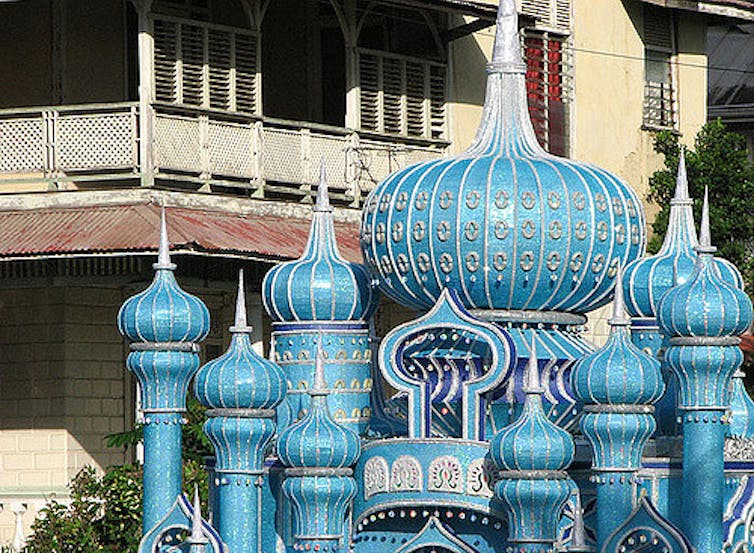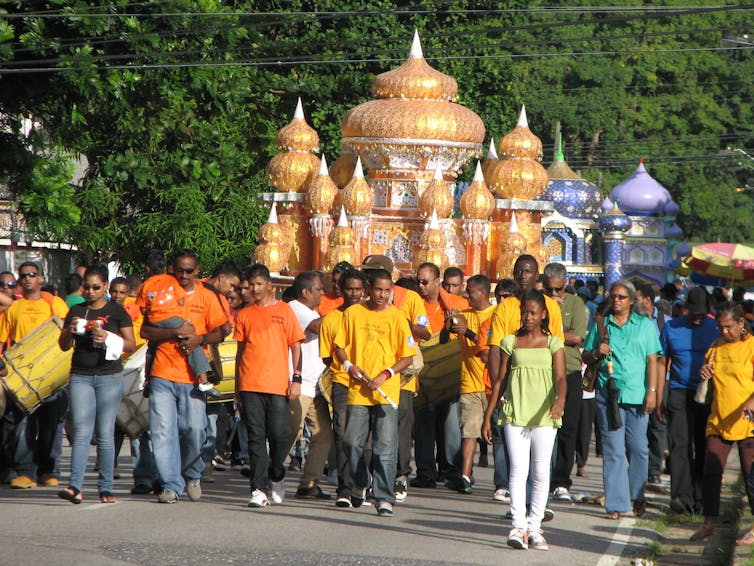
Dr.Mazhar Naqvi
What was started as a Muslim Indo-Caribbean commemoration of Imam Hussain’s martyrdom has grown
into a national festival observed in Trinidad and Tobago, Guyana, Suriname,
and Jamaica,
thanks to active participation to the Hindus who were sent by the British as
herds along with followers of Islam. To be honest, these migrants faithfully
carried on in Caribbean islands the joint observance of Muharram by Hindus and Muslims alike in
colonial India.
The festival is observed as Hosay (derived
from the blessed name of martyr of humanity Hazrat Imam Hussain) is now
witnessed the participation of Christians in large number as well. In Trinidad
and Tobago, multi-colored Tazia’s (Replicas of Imam’s shrine in Karbala in
modern day Iraq) wend their way to beaches for immersion during Muharram. They
call it 'Tadjah' derived from the Arabic word Ta'zieh and
signifies different cultural meanings depending on the region, time period,
occasion, and religion. In British Guiana, (now called Guyana),
and Suriname,
the festival is kno0wn as Taziya or
creolized into Tadjah in reference to these floats, arguably the most visible
and decorative element of Muharam rituals.
Like Shia
world, Hosay lasts for 10 days and is observed in accordance with the Islamic lunar calendar and in line
with ten days Ashura commemorated
by Imamis across the globe.The last four days are the most popular as the first
six days are days of fasting, prayer and building of the “Tadjahs” and “Moons”.

Although
Hosay was traditionally commemorated for Husain, its observance in recent times
has adopted all types of shades and characters from other religions
including Roman Catholics, Hindus and Baptists,
making the modern event a mixture of different cultures and religions.
The event is attended by both Muslims and non-Muslims, depicting an environment
of mutual respect and tolerance. A unique design of Tadja can be found during
the Hosay celebrations in Cedros, a coastal village situated in the
South-Western end of Trindad, that are built in an exclusive style that is not
found anywhere else in the world, in terms of the art and style of
construction.
In
nineteenth-century Trinidad newspapers as well as government reports called
Hosay the "Coolie Carnival." as the custom was initiated by Indians who
were sent mostly as porters in Caribbean islands by their British masters.
In Trinidad, the 100,000 Muslims who make up 5 percent of
the island’s total population, celebrate the day of Ashura, as Hosay – the name
derived from “Hussein.”
The
first Hosay festival was held in 1854, just over a decade after the first
Indian Muslims began to arrive from India to work on the island’s sugar
plantations.Trinidad at the time was under British colonial rule and large
public gatherings were not permitted. In 1884, the British authorities issued a prohibition against Hosay commemorations. Approximately
30,000 people took to the streets, in Mon Repos, in the south, to protest
against the ordinance. Shots fired to disperse the crowd killed 22 and injured
over 100. The ordinance was later overturned.
Each Tadjah is constructed of wood,
paper, bamboo and tinsel. Ranging from a height of 10 to 30 feet, the floats
are accompanied by people parading along and others playing drums, just as is
the practice in India’s northern city of Lucknow. Meant to reflect the resting
place of Shiite martyrs, the Tadjahs resemble mausoleums in India. To many,
their domes might be a reminder of the Taj Mahal.
Walking ahead of the Tadjahs are two men
bearing crescent moon shapes, one in red and the other in green. These
symbolize the deaths of Hussein and his brother Hassan – the red being
Hussein’s blood and the green symbolizing the supposed poisoning of Hassan.
The
elaborateness of the Tadjahs continues to increase each year and has become
somewhat of a status symbol and display of their Indian roots among the
families that sponsor them. While the festival is certainly a somber one in
terms of its tribute, it is also a joyous occasion where families celebrate
with loud music and don festive attire. This has led some to compare Hosay to
Trinidad’s world-famous carnival with its accompanying “joie de
vivre.”
But
there are also those who believe that the occasion should be a more somber
remembrance of the martyrdom of Hussain. More conservative Muslims in Trinidad
have made attempts to “reform” such celebrations.
These Muslims believe local customs should be more in line with global
commemorations like those in Iraq, Iran, Pakistan or India.
Currently, Muharram is an assertion of
both the Indian Hindus and Muslims and Trinidadian identity. For them, who have
dealt with oppression and ostracism – both in the past and in the present – it
is a means of claiming their space as a minority in Trinidadian culture and
resisting being pushed to the margins. At the same time, with its carnival-like
feel, gives the occasion famous Happy Go Lucky type Trinidadian touch. Indeed, Muharram
each year illustrates how Indian and Trinidadian rituals and material culture
merged to create a unique festival.
Muharam-2019 was no exception with Trinidadians thronged in large
number along the streets of St. James and Cedros to admire the vibrant floats
with beautifully bedecked Tajdahs.
Source: Wikipedia/ Ken Chitwood’s article in ‘The
conversation’/Photo Courtesy Google images)
No comments:
Post a Comment